七年级英语下册电子版教案
人教版七年级下册全册英语教学的教案
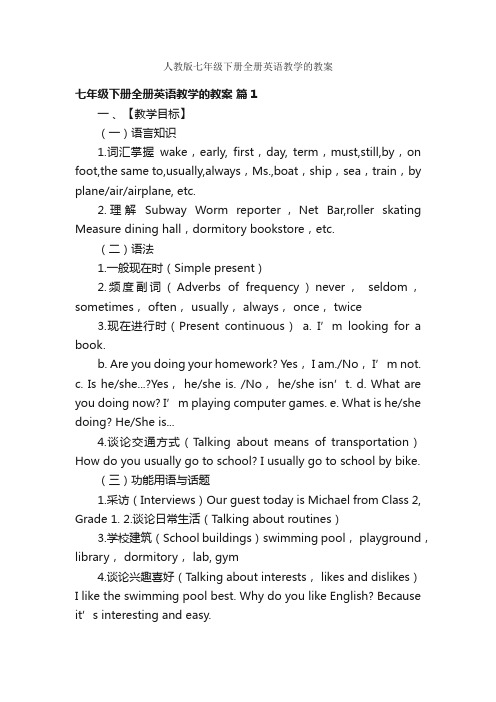
人教版七年级下册全册英语教学的教案七年级下册全册英语教学的教案篇1一、【教学目标】(一)语言知识1.词汇掌握wake,early, first,day, term,must,still,by,on foot,the same to,usually,always,Ms.,boat,ship,sea,train,by plane/air/airplane, etc.2.理解Subway Worm reporter,Net Bar,roller skating Measure dining hall,dormitory bookstore,etc.(二)语法1.一般现在时(Simple present)2.频度副词(Adverbs of frequency)never,seldom,sometimes, often, usually, always, once, twice3.现在进行时(Present continuous)a. I’m loo king for a book.b. Are you doing your homework? Yes, I am./No,I’m not.c. Is he/she...?Yes, he/she is. /No,he/she isn’t.d. What are you doing now? I’m playing computer games.e. What is he/she doing? He/She is...4.谈论交通方式(T alking about means of transportation)How do you usually go to school? I usually go to school by bike.(三)功能用语与话题1.采访(Interviews)Our guest today is Michael from Class 2, Grade 1.2.谈论日常生活(Talking about routines)3.学校建筑(School buildings)swimming pool, playground,library, dormitory, lab, gym4.谈论兴趣喜好(Talking about interests, likes and dislikes)I like the swimming pool best. Why do you like English? Because it’s interesting and easy.5.借物(Borrowing things)How long can I keep it? Two weeks.6.新闻(News)、海报(Poster)Attention,please! Here is the news.7.谈论学校活动、科目和时间表(Talking about school activities,subjects and timetable)8.谈论学校生活(Talking about school life)(四)能力培养【听】能听懂谈论校园生活中比较熟悉的话题,识别主题,获取主要信息。
七年级下册英语课教案(优秀5篇)

七年级下册英语课教案(优秀5篇)(经典版)编制人:__________________审核人:__________________审批人:__________________编制单位:__________________编制时间:____年____月____日序言下载提示:该文档是本店铺精心编制而成的,希望大家下载后,能够帮助大家解决实际问题。
文档下载后可定制修改,请根据实际需要进行调整和使用,谢谢!并且,本店铺为大家提供各种类型的经典范文,如合同协议、条据文书、策划方案、总结报告、党团资料、读书笔记、读后感、作文大全、教案资料、其他范文等等,想了解不同范文格式和写法,敬请关注!Download tips: This document is carefully compiled by this editor. I hope that after you download it, it can help you solve practical problems. The document can be customized and modified after downloading, please adjust and use it according to actual needs, thank you!Moreover, our store provides various types of classic sample essays, such as contract agreements, documentary evidence, planning plans, summary reports, party and youth organization materials, reading notes, post reading reflections, essay encyclopedias, lesson plan materials, other sample essays, etc. If you want to learn about different formats and writing methods of sample essays, please stay tuned!七年级下册英语课教案(优秀5篇)教案是备课的展示与体现,至于采取何种形式还得根据教师实际而定。
人教版英语七年级下册全套电子教案(可直接打印使用)
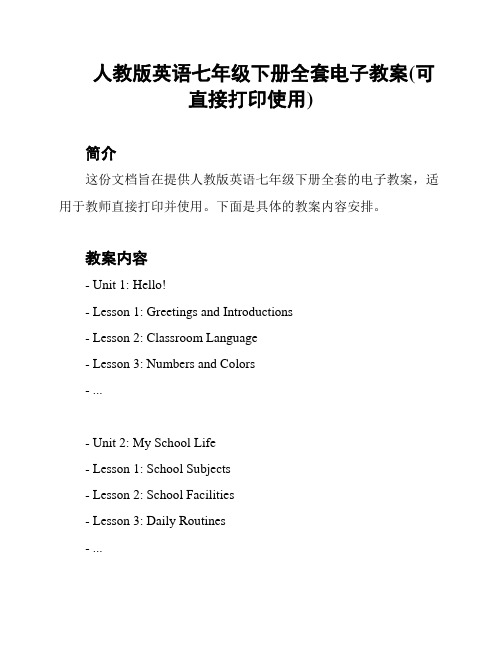
人教版英语七年级下册全套电子教案(可直接打印使用)简介这份文档旨在提供人教版英语七年级下册全套的电子教案,适用于教师直接打印并使用。
下面是具体的教案内容安排。
教案内容- Unit 1: Hello!- Lesson 1: Greetings and Introductions- Lesson 2: Classroom Language- Lesson 3: Numbers and Colors- ...- Unit 2: My School Life- Lesson 1: School Subjects- Lesson 2: School Facilities- Lesson 3: Daily Routines- ...- Unit 3: My Family- Lesson 1: Family Members- Lesson 2: Describing Family Members - Lesson 3: Daily Life- ...- Unit 4: My Friends- Lesson 1: Making Friends- Lesson 2: Describing People- Lesson 3: Talking about Hobbies- ...- Unit 5: My Day- Lesson 1: Daily Activities- Lesson 2: Time and Schedules- Lesson 3: Talking about the Weekend - ...- Unit 6: My Free Time- Lesson 1: Leisure Activities- Lesson 2: Likes and Dislikes- Lesson 3: Planning for the Future - ...- Unit 7: Summer Vacation- Lesson 1: Vacation Plans- Lesson 2: Talking about Places- Lesson 3: Past Experiences- ...- Unit 8: Festivals and Celebrations - Lesson 1: Chinese Festivals- Lesson 2: Western Festivals- Lesson 3: Celebrating with Friends - ...- Unit 9: At the Farm- Lesson 1: Farm Animals- Lesson 2: Talking about Farm Work - Lesson 3: Farm Produce- ...- Unit 10: Environmental Protection- Lesson 1: Environmental Problems- Lesson 2: Actions for the Environment- Lesson 3: Protecting Our Earth- ...使用说明- 教案可根据需要直接打印使用。
七年级下册英语优质课教案设计4篇
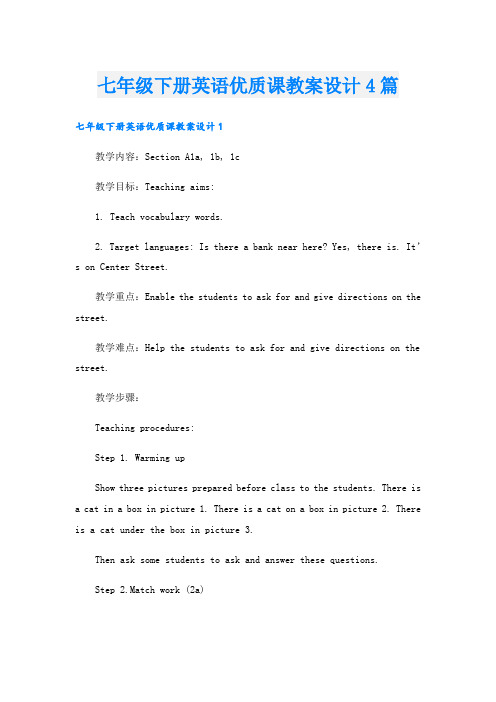
七年级下册英语优质课教案设计4篇七年级下册英语优质课教案设计1教学内容:Section A1a, 1b, 1c教学目标:Teaching aims:1. Teach vocabulary words.2. Target languages: Is there a bank near here? Yes, there is. It’s on Center Street.教学重点:Enable the students to ask for and give directions on the street.教学难点:Help the students to ask for and give directions on the street.教学步骤:Teaching procedures:Step 1. Warming upShow three pictures prepared before class to the students. There is a cat in a box in picture 1. There is a cat on a box in picture 2. There is a cat under the box in picture 3.Then ask some students to ask and answer these questions.Step 2.Match work (2a)Ask the students to read the picture and the words in the numbered list.Ask the students to match each word or phrase on the list with one of the pictures.Then check the answers.Present the new sentence patterns.Then ask the students to read the dialogue in the picture.Step 3. Listening (1b)Ask the students to listen to the conversations and circle the places in 1a.Change the roles and do the same again.Then students ask and answer without the help of the recording.Step 4. PracticePoint to the different locations shown in the picture. Ask different students to name each one.Then point to more locations and let the students to practice more.Homework1. Practice the conversation in the picture on page 7.2. Learn the new words and phrases in this period by heart.七年级下册英语优质课教案设计2Why do you like koalas?单元备课Language goals:l In this unit students learn to describe animals and express preferences.New languages:l Let’s see the pandas first.l Why do you like want to see the pandas?l Because they are very cute.l Because they’re kind of shy.l Because they’re kind of interesting.l Because they are fun.l Because they are smart.l Do you like giraffes?l Where are lions from?l They are from South Africa.l The animal is ugly / beautiful / friendly / small / shy / clever / cute / scary.l She likes to play with her friends and eat grass.l She’s very beautiful, but she’s very shy, so please be quiet.l He sleeps during the day, but at night he gets up and eats leaves.Difficult points:1. Listening for the names of animals. Listen for the description words about animals.2. Read the description words about animals. Write about the animal you know.3. why, what, where questions, because, adjectives of qualityTeaching aids:l A tape recorderl Some picturesTeaching periods:l Period 1: Section A1a, 1b, 1cl Period 2: Section A2a, 2b, 2cl Period 3: Section A3a, 3b, 4l Period 4: Section B 1a, 1b, 1c, 2a, 2b, 2cl Period 5: Section B 3a, 3b, 3c, 4l Period 6: Self Check七年级下册英语优质课教案设计3教学目标知识目标能正确运用词汇markt supermart,biscuit,lemon,strawberryMotherday ,size,takemay,try on,certainly,wait a minute,sale,price,look,fresh 七年级下册英语优质课教案设计4一、教学目标:1. 语言知识目标:1)2)①— No, I cant. / Yes, I can.②…③ help2.可以培养学生的社会责任意识,为他人做自己力所能及的事。
初中七年级英语下册教案五篇(精编版)
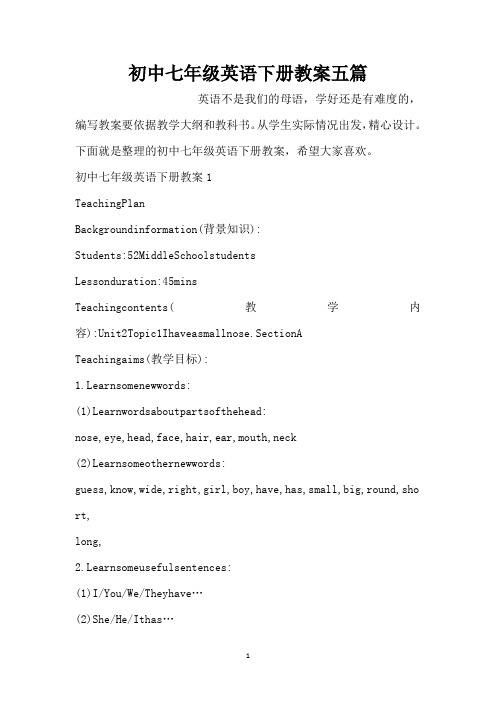
初中七年级英语下册教案五篇英语不是我们的母语,学好还是有难度的,编写教案要依据教学大纲和教科书。
从学生实际情况出发,精心设计。
下面就是整理的初中七年级英语下册教案,希望大家喜欢。
初中七年级英语下册教案1TeachingPlanBackgroundinformation(背景知识):Students:52MiddleSchoolstudentsLessonduration:45minsTeachingcontents(教学内容):Unit2Topic1Ihaveasmallnose.SectionATeachingaims(教学目标):1.Learnsomenewwords:(1)Learnwordsaboutpartsofthehead:nose,eye,head,face,hair,ear,mouth,neck(2)Learnsomeothernewwords:guess,know,wide,right,girl,boy,have,has,small,big,round,sho rt,long,2.Learnsomeusefulsentences:(1)I/You/We/Theyhave…(2)She/He/Ithas…(3)---Doyouhave…?---Yes,I/Wedo.No,I/Wedon’t.(4)---Iknow.---You’reright.3.Learnhowtodescribepeople’sappearances.Teachingfocus(重点):wordsaboutpartsoftheheadandadjectivesof descriptionTeachingdifficulties(难点):Theusagesofhaveandhas Teachingprocedures:(教学步骤)Step1Warm-up第一步热身greetingsingasong:Headandshoulders.Step2Review第二步复习(1)通过复习,培养学生根据卡片信息进行简单交流的能力。
七年级下册英语教案优秀5篇
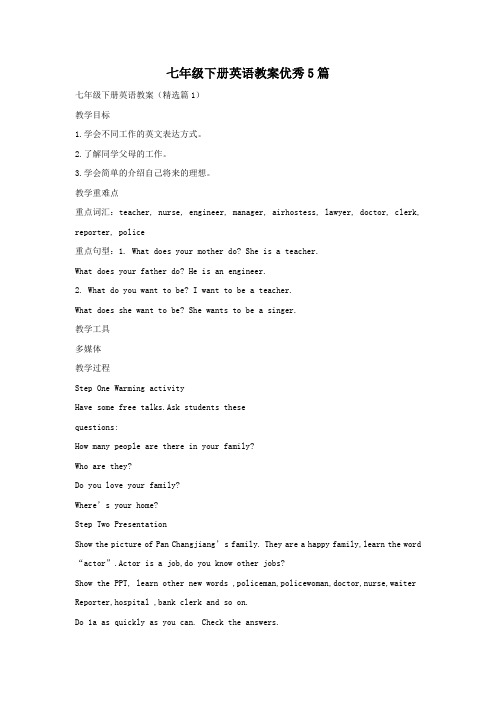
七年级下册英语教案优秀5篇七年级下册英语教案(精选篇1)教学目标1.学会不同工作的英文表达方式。
2.了解同学父母的工作。
3.学会简单的介绍自己将来的理想。
教学重难点重点词汇:teacher, nurse, engineer, manager, airhostess, lawyer, doctor, clerk, reporter, police重点句型:1. What does your mother do? She is a teacher.What does your father do? He is an engineer.2. What do you want to be? I want to be a teacher.What does she want to be? She wants to be a singer.教学工具多媒体教学过程Step One Warming activityHave some free talks.Ask students thesequestions:How many people are there in your family?Who are they?Do you love your family?Where’s your home?Step Two PresentationShow the picture of Pan Changjiang’s family. They are a happy family,learn the word “actor”.Actor is a job,do you know other jobs?Show the PPT, learn other new words ,policeman,policewoman,doctor,nurse,waiter Reporter,hospital ,bank clerk and so on.Do 1a as quickly as you can. Check the answers.Step Three New drillsT: I’m a teacher. (Ask one student What do you do?) Help the student answer I’m a student. Then ask several students.T: What do you do?S1: I’m a student.(Point to another boy)T: What does he do?S1: He is a student.T: What do you do?(Ask a girl)S2:I’m a student.(Point to this girl,ask another student)T:What does she do?S3:She is a student.T:What does your mother do?S4:She is a farmer.T:What does your father do?S4:He is a worker.Ask some Ss to answer the questions.Open your books,do 1b.Play the tape.Step 4 Task 1Make a survey and report about your group.Name Mother’s job Father’s jobStep 5 Task 2Play a guessing game.Step 6 Exercises1.I want to be a d_____ like Hua Tuo.2.My sister is a nurse,she works in ah_______.3.Cheng Long is a famous a____,Gong Li is afamous a_______.4.The two boys want to be __________(policeman)when they grow up.5.--What ___ you ___(do)? --I am a teacher.6.He is a shop assistant.(划线提问)____ ____ he ____?Step 7 Summary and HomeworkMake a survey ,ask your parents or three of your friends using the question” What do you want to be?” and fill in the chart.课后小结本节课的不足之处,由于本节课的内容较简单,所以在各个任务环节的难度梯度不是很明显。
(完整版)人教版七年级英语下册全册教案

人教版七年级英语下册全册教案Unit1 Where is your pen pal from?Topic:Countries, nationalities, and languagesFunctions:Talk about countries, nationalities and languagesAsk and tell about where people liveStructure:Where's/Where're ...from?Where does/do ...from?What questions----What language does/do ...speak?Target language:Where is she from? She is from....Where does she live? She lives in....What language does she speak? She speaks....V ocabulary:words about countries, languagesTeaching design:The whole unit needs 5 periods, 4 for new lessons and 1 for testPeriod 1 ( 1a----Grammar Focus )Key points:Where is your/John's pen pal from? He/She is from...Where does he/she live? He/She lives in....(Homework for preview)Pre-task:Let the Ss give themselves pen pals and they should write down their pen pals' information, such as their names, countries and cities they live even the language they speak.T can give the Ss an example meanwhile T gives the different countries which can be used by the Ss. T gives the Ss Chinese words for the countries, they are following: 加拿大,法国,日本,美国,澳大利亚,新加坡,英国,中国( The Ss can look them up in the dictionary if they are new for them)The example is following:Name: Curry MurayAge: 75From(Nationality): the United StatesCity: New YorkLanguage: EnglishTeaching Steps:Key points:Where is your/John's pen pal from? He/She is from...Where does he/she live? He/She lives in....(Homework for preview)Pre-task:Let the Ss give themselves pen pals and they should write down their pen pals' information, such as their names, countries and cities they live even the language they speakT can give the Ss an example meanwhile T gives the different countries which can be used by the Ss. T gives the Ss Chinese words for the countries, they are following: 加拿大,法国,日本,美国,澳大利亚,新加坡,英国,中国( The Ss can look them up in the dictionary if they are new for them)The example is following:Name: Curry MurayAge: 75From(Nationality): the United StatesCity: New YorkLanguage: EnglishTeaching Steps:Step 1 Leading-inThe information of the teacher's own pen pal's information."I have a pen pal. His name is Curry Muray. He is from the United States.Do you have a pen pal? Where is your pen pal from? What's your pen pal's name?"Different students say the information about their own pen pals. T should choose the different countries. T writes the different countries on the Bb(both Chinese and English)Step 2 LearningSection A 1a Learn the new words on the Bb. The new words are: pen pal; Canada; France; Japan; the United States(the US/the USA/America); Australia; Singapore; the United Kingdom(the U.K./Great Britain/England)Pay attention to the pronuciation of the new words.Step 3 Listening1b Listen and circle the countries in 1a they learnedStep 4 CompetitionTwo groups of students to write the new words to see which group does better. First write down the Chinese words with looking at the English meanings, then write down the English words with looking at the Chinese meanings.(This step is a memory game. It can help the Ss consolidate the new words they learned)Step 5 Pairwork1c Practise the following conversation:---Do you have a pen pal? ---Yes, I do.---Where's your pen pal's from? ----He/She is from ....(Write it down on the Bb)First T has a conversation with one student as an example then let the Ss practise in pairs. At last let several pairs do it again in class.Step 6 Leading-inRevise the countries names with looking at the Bb. Then T writes down the city names on the Bb. Let the Ss try to find out which countries the cities are in. The city names are following:Toronto; Paris; Tokyo; New York; Sydney; Singapore; London;Step 7 Learning2a Learn the city names together with the whole class just like Step 2 2b Listen and circle the cities and countries2c Listen and complete the chartHave a similar competition to consolidate the new words in this part.Step 8 PairworkT has a conversation with one student like the following:---Do you have a pen pal? ---Yes, I do.---What's your pen pal's name? ---His/Her name is....---Where is your pen pal from? ---He/She is from...---Where does he/she live? ---He/She lives in....(Write it down on the Bb)Let the Ss practise after the T's example in pairs then several pairs do it in class.Step 9 ExerciseMy pen pal is from Australia.(划线提问)John's pen pal is from Japan. (划线提问)He lives in Paris. (划线提问)Homework:Read and copy the new words .Copy the sentences in Grammar FocusMake up the questions about Jodie in 2c The questions are:Does Jodie have a pen pal? Where is Jodie's pen pal from? Where does he/she live? What's his/her name?(This one can be chosen by themselves) Unit 2 Where's the post office?Language goalThis unit students leam to ask for and give directions(方向) on the street. New languageIs there a bank near here? Yes, there's a bank on Center Street, Where's the supermarket? It's next to the library.Is there a pay phone in the neighbhood?Yes, it's on Bridge Street on the right.locations in the neighborhood such as post office, hotel,video arcade.Descriptive words such as new, old, dirty, clean.Descriptions of location such as across from, next to,BetweenRecycled languageWhat are you doing?Do you want to ...?Section AAsk two rows of three students each to stand facing each other in the front of the classroom. Point to students standing in front and ask the class to repeat the questions and answers.Example 1Teacher: Where'sYang Li? (Point to two students standing beside each other.) Yang Li is next to Li Peng.Example 2Teacher: Where's Zheng Wen? (Point to two students in different lines facing each other.)Zheng Wen is across from Sheng Lin.Example 3Teacher: Where's Lin Jiahui? (Point to one student standing between two other students.) Lin Jiahui is between Sheng Lin and Li Dai.la This activity introduces the key vocabulary.Focus attention on the picture. Ask students to name as many of the places they see in the picture as they can.Then name all the places and ask students to repeat.Point out the numbered list of words. Say each one and ask students to repeat.Then ask students to match each word or phrase on the list with one of the pictures. Say, Write the letter of each place in the picture next to the correct word or words on the list. Point out the sample answer f.Check the answers.1b This activity gives students practice listening to and understanding the target language.Point out the buildings and other locations in the picture. Say the name of each one to the class.Say, Now I will play recordings of three conversations. Listen carefully and circle the picture of each place you hear on the tape..Play the recording the first time. Students only listen.Play the recording a second time. This tine ask students to listen and circle the items they hear on the picture.Correct the answers.These items should be circle:video arcade, post office, supermarket.Tapescript(录音稿)Convernation 1A: Is there a video arcade on Fifth Avenue?B: Yes, there is.Conversation 2A: Is there a post office near here?B: Yes, there is. There's one on Bridge Street.Conversation 3A: Is there a supermarket on Center Street?B: No, there isn't.1C This activity provides guided oral practice using the target language.Point to the different locations shown in the picture.Ask different students to name each one. If necessary,say the name and ask the student to repeat.Point to the question and answer In the example conversation and ask a pair of students to read the conversation to the class. Ask other pairs of students to repeat the activity if you wish.Ask students to work in pairs. Say, First one person asks a question and then the other person takes a turn.Demonstrate(示范)the activity. Point to the picture and ask. Is there a post office near here? Then choose a student to answer. Guide the student to say, Yes,there's a post office on Bridge Street.As students work, move around the room and check progress(进展情况). Help students understand how to locate things on the map, if necessary.Ask several students to say some of their questions and answers for the class.教学后记:教学方法有问题?教了这么多年的英语,总幻想有一种方法,能让学生轻轻松松把英语学好。
最新人教版七年级英语下册全英文教案(全册 全英文)

七年级英语下册全英文教案(全册全英文)Unit 1 Can you play the guitar?Step 1 LeadingT:What do they do in the picture?S:They...(见课件)T:Can you/he sing/ swim/ dance...?S:I/He can...T:There are many clubs.What club do you want to join?(见课件)S:I want to join the music club.Because I can sing....Step 2 Listening1.Ask the students to read the conversations in 1b first.2.Ask the students to listen and number the conversations [1-3] in 1b.3.Check the answers.(见课件)4.Ask the students to read the club names in 2a.5.As k the students to listen to two conversations and circle the clubs they hear.6.Ask one student to show the answers.(见课件)7.Listen again and complete the sentences in 2b.8.Ask three students to show their answers.(见课件)Step 3 Make similar conversations1.Look at 2b and talk ab out what the people can do and the clubs they want to join.2.Show an example.(见课件)Step 4 Role-play1.Ask the students to read the conversation in 2d,try to find:What can Jane/ Bob do?What club do they want to join?2.Ask the students to fill in the form.(见课件)What can...do? What club does...want to join? BobJane3.Ask students to practice the conversation according to the for m.4.Ask students to perform the conversation.Step 5 Explain several important words and phrases.(见课件)Step 6 HomeworkMake a survey about what your friends can do and what club your friends want to join. 板书设计Section A(1a-2d)重点单词短语重点句型1.play the guitar/play basketball2.want to do sth.3.join/join in/take part i n4.be good atUnit 1 Can you play the guitarImportant phrases:talk to,kung fuImportant sentences:1.—Can yo u/he/they swim?—Yes,I/he/they can./—No,I/he/they can’t.2.—What can you do?—I can dance./ I can’t sing.3.—What club do you want to join?—We want to join the chess club.【能力目标】能熟练运用所学目标语言谈论自己所长。
2021七年级英语下册教学设计教案5篇七年级英语教学设计教
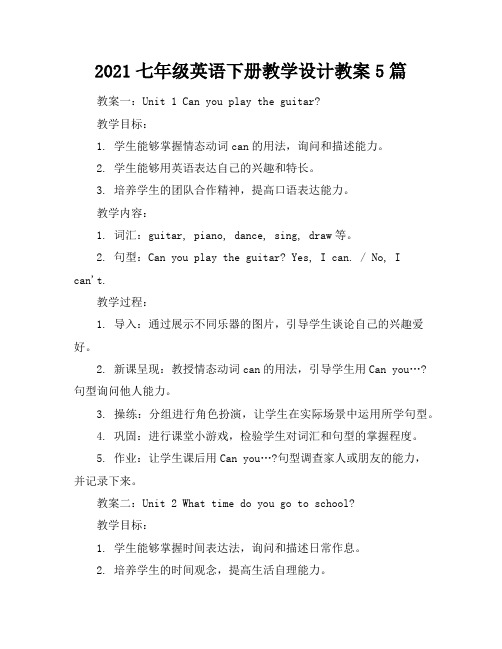
2021七年级英语下册教学设计教案5篇教案一:Unit 1 Can you play the guitar?教学目标:1. 学生能够掌握情态动词can的用法,询问和描述能力。
2. 学生能够用英语表达自己的兴趣和特长。
3. 培养学生的团队合作精神,提高口语表达能力。
教学内容:1. 词汇:guitar, piano, dance, sing, draw等。
2. 句型:Can you play the guitar? Yes, I can. / No, Ican't.教学过程:1. 导入:通过展示不同乐器的图片,引导学生谈论自己的兴趣爱好。
2. 新课呈现:教授情态动词can的用法,引导学生用Can you…?句型询问他人能力。
3. 操练:分组进行角色扮演,让学生在实际场景中运用所学句型。
4. 巩固:进行课堂小游戏,检验学生对词汇和句型的掌握程度。
5. 作业:让学生课后用Can you…?句型调查家人或朋友的能力,并记录下来。
教案二:Unit 2 What time do you go to school?教学目标:1. 学生能够掌握时间表达法,询问和描述日常作息。
2. 培养学生的时间观念,提高生活自理能力。
教学内容:1. 词汇:o'clock, usually, often, always等。
2. 句型:What time do you go to school? I usually go to school at 7 o'clock.教学过程:1. 导入:通过谈论学生的日常作息,引导学生关注时间表达。
2. 新课呈现:教授时间表达法,引导学生用What time do you…?句型询问他人作息。
3. 操练:分组进行对话练习,让学生在实际场景中运用所学句型。
4. 巩固:进行课堂小游戏,检验学生对词汇和句型的掌握程度。
5. 作业:让学生课后记录自己一周的作息时间,并用所学句型进行描述。
七年级英语下册教案(全册)
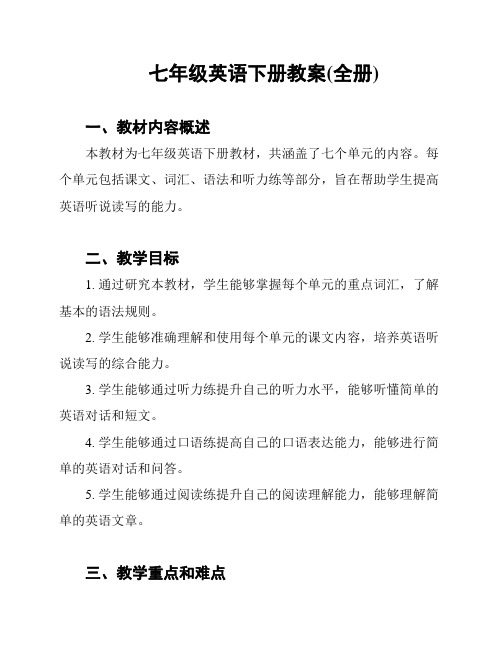
七年级英语下册教案(全册)一、教材内容概述本教材为七年级英语下册教材,共涵盖了七个单元的内容。
每个单元包括课文、词汇、语法和听力练等部分,旨在帮助学生提高英语听说读写的能力。
二、教学目标1. 通过研究本教材,学生能够掌握每个单元的重点词汇,了解基本的语法规则。
2. 学生能够准确理解和使用每个单元的课文内容,培养英语听说读写的综合能力。
3. 学生能够通过听力练提升自己的听力水平,能够听懂简单的英语对话和短文。
4. 学生能够通过口语练提高自己的口语表达能力,能够进行简单的英语对话和问答。
5. 学生能够通过阅读练提升自己的阅读理解能力,能够理解简单的英语文章。
三、教学重点和难点1. 教学重点:重点词汇、基本语法规则、课文内容的理解和运用、口语表达的练和提高、阅读理解能力的培养。
2. 教学难点:理解课文中的长难句,正确运用语法规则,进行连贯的口语表达。
四、教学方法与活动安排1. 教学方法:采用多种教学方法,如师生互动、小组合作、游戏活动等,激发学生研究的积极性和兴趣。
2. 活动安排:每个单元的教学可以按照以下步骤进行:- 课前预:学生预课文内容,了解重点词汇和基本语法规则。
- 听力练:学生通过听力练提高自己的听力水平,能够听懂简单的英语对话和短文。
- 课文研究:学生跟读课文,理解课文内容并进行相关练。
- 语法练:学生进行语法练,巩固语法知识。
- 口语练:学生进行口语练,提高口语表达能力。
- 阅读练:学生进行阅读练,培养阅读理解能力。
- 小结与评价:对本单元的研究进行小结和评价,帮助学生巩固所学知识。
五、评价与反馈1. 通过个人作业和课堂表现评价学生的语言能力和研究情况。
2. 针对学生的不足之处给予及时反馈和建议,帮助学生改进和提高。
3. 定期进行测试和考试,评估学生的研究成果。
六、教学资源1. 教材:七年级英语下册教材。
2. 多媒体设备:投影仪、电脑等用于呈现教学内容和活动。
3. 音频设备:用于播放听力材料。
七年级下册英语教案(5篇)

七年级下册英语教案(5篇)七年级下册英语教案篇1一、学生情况简析七年级共两个班,大部分学生学习目的明确,学习态度端正,掌握了英语学习的一些基本方法,能够积极主动认真地学习,学习成绩较好。
但还有少部分学生没有明确学习目的,缺少学习的热情和主动性,自觉性和自控力都较差,相应的学习习惯也差。
,学生觉得英语学习是一种负担,而不是一种乐趣。
一部分学生没有掌握记忆单词的方法,连基本的单词听写也不过关,导致看不懂,听不懂,学不懂。
二、教材总体分析七年级下册英语共十二个单元,另外还有两个复习单元,每个单元都列出明确的语言目标,主要的功能项目与语法结构,需要学生掌握的基本词汇,并分为A、B两部分。
A部分以一副展示新功能在实际生活中运用的图画开篇。
该图引出了学生在操练新语言时需要用到的重点词汇。
所有重点单词都在图画中描绘出来,因此学生不需解释或翻译就能理解它们。
新的表达方式呈现在人物头上的气泡中,从而使学生很容易理解和操练新语言。
B部分在循环A部分所呈现的语言同时引出新的词汇。
同时,B部分的活动帮助学生整合新的目标语言和前面单元学过的语言。
这一循环强化了前面的语言学习,同时为新学语言提供了更多的操练机会。
三、教学目标1、词汇方面:掌握本册教材中的词汇,学会根据单词的读音规则去记忆单词,掌握单词,词组的用法。
2、语言结构方面:学会谈论人们的国籍,居住城市,学会询问及表达某一场所的位置,学会描述动物,表达喜好并陈述原因,学会谈论自己与他人的职业,学会谈论人们正在做的事情,描述并谈论天气,表达自己对天气的喜好及原因,描述某人的外貌特征,订餐或点菜,表达过去发生的事情,交流对某人,某事,某物的看法等。
3、语法知识方面:掌握一般现在时与现在进行时的构成形式与用法,一般运去时的构成形式与用法,祈使句的用法,情态动词“can"的用法,there be结构的用法,介词的用法。
四、方法与措施1、加强词汇教学。
2.认真执行晨读制度:规定晨读内容,加强监督,保证晨读效果。
七年级下册英语教案(精选10篇)
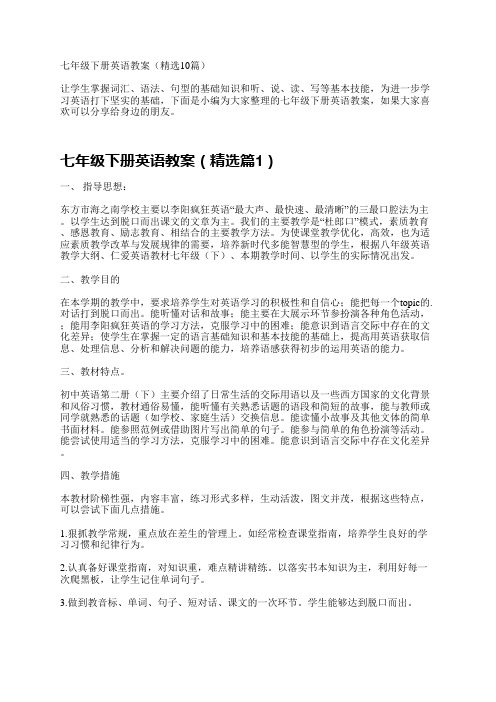
七年级下册英语教案(精选10篇)让学生掌握词汇、语法、句型的基础知识和听、说、读、写等基本技能,为进一步学习英语打下坚实的基础,下面是小编为大家整理的七年级下册英语教案,如果大家喜欢可以分享给身边的朋友。
七年级下册英语教案(精选篇1)一、指导思想:东方市海之南学校主要以李阳疯狂英语“最大声、最快速、最清晰”的三最口腔法为主。
以学生达到脱口而出课文的文章为主。
我们的主要教学是“杜郎口”模式,素质教育、感恩教育、励志教育、相结合的主要教学方法。
为使课堂教学优化,高效,也为适应素质教学改革与发展规律的需要,培养新时代多能智慧型的学生,根据八年级英语教学大纲、仁爱英语教材七年级(下)、本期教学时间、以学生的实际情况出发。
二、教学目的在本学期的教学中,要求培养学生对英语学习的积极性和自信心;能把每一个topic的.对话打到脱口而出。
能听懂对话和故事;能主要在大展示环节参扮演各种角色活动,;能用李阳疯狂英语的学习方法,克服学习中的困难;能意识到语言交际中存在的文化差异;使学生在掌握一定的语言基础知识和基本技能的基础上,提高用英语获取信息、处理信息、分析和解决问题的能力,培养语感获得初步的运用英语的能力。
三、教材特点。
初中英语第二册(下)主要介绍了日常生活的交际用语以及一些西方国家的文化背景和风俗习惯,教材通俗易懂,能听懂有关熟悉话题的语段和简短的故事,能与教师或同学就熟悉的话题(如学校、家庭生活)交换信息。
能读懂小故事及其他文体的简单书面材料。
能参照范例或借助图片写出简单的句子。
能参与简单的角色扮演等活动。
能尝试使用适当的学习方法,克服学习中的困难。
能意识到语言交际中存在文化差异。
四、教学措施本教材阶梯性强,内容丰富,练习形式多样,生动活泼,图文并茂,根据这些特点,可以尝试下面几点措施。
1.狠抓教学常规,重点放在差生的管理上。
如经常检查课堂指南,培养学生良好的学习习惯和纪律行为。
2.认真备好课堂指南,对知识重,难点精讲精练。
七年级下册英语全册教案全册
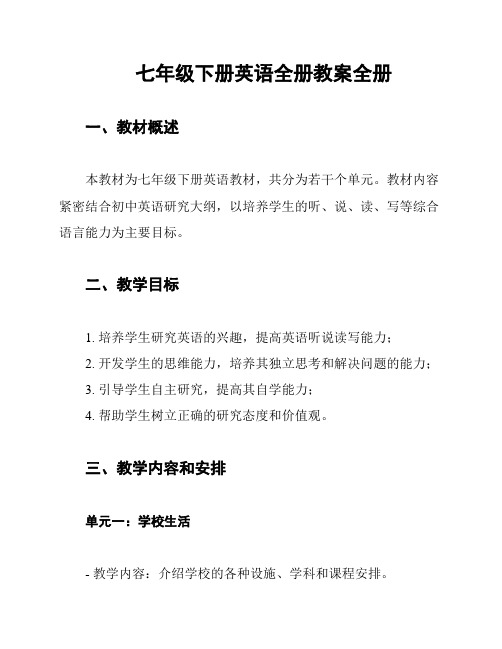
七年级下册英语全册教案全册一、教材概述本教材为七年级下册英语教材,共分为若干个单元。
教材内容紧密结合初中英语研究大纲,以培养学生的听、说、读、写等综合语言能力为主要目标。
二、教学目标1. 培养学生研究英语的兴趣,提高英语听说读写能力;2. 开发学生的思维能力,培养其独立思考和解决问题的能力;3. 引导学生自主研究,提高其自学能力;4. 帮助学生树立正确的研究态度和价值观。
三、教学内容和安排单元一:学校生活- 教学内容:介绍学校的各种设施、学科和课程安排。
- 教学安排:- 第一课:学校设施介绍- 第二课:学校科目介绍- 第三课:我的课程表单元二:家庭与朋友- 教学内容:描述家庭成员、朋友和家庭活动。
- 教学安排:- 第一课:我的家庭- 第二课:我的朋友- 第三课:家庭活动单元三:日常生活- 教学内容:介绍日常活动和惯。
- 教学安排:- 第一课:我的日常活动- 第二课:日常惯- 第三课:日常生活中的问题与解决方法单元四:购物- 教学内容:研究购物相关的词汇和句型。
- 教学安排:- 第一课:购物场所- 第二课:购物物品- 第三课:购物对话单元五:健康与运动- 教学内容:研究有关健康和运动的知识。
- 教学安排:- 第一课:健康饮食- 第二课:运动项目- 第三课:我的运动日记单元六:节日与庆祝- 教学内容:介绍不同节日的庆祝活动。
- 教学安排:- 第一课:春节- 第二课:圣诞节- 第三课:其他节日单元七:环境保护- 教学内容:研究保护环境的方法和意义。
- 教学安排:- 第一课:保护环境的意义- 第二课:环保行动- 第三课:我的环保计划四、教学方法本教案采用多种教学方法,包括听说读写结合的综合教学法、任务型教学法、情景教学法等,以提高学生的综合语言能力。
五、教学评价通过课堂表现、作业完成情况、小组合作等方式进行教学评价,帮助学生发现自己的优势和不足,及时调整研究策略,提高研究效果。
六、教学资源教学资源主要包括教科书、教学辅助资料、多媒体设备等,通过多样化的教学资源提供适应不同研究需求的教学材料。
七年级下册英语教案汇总5篇

七年级下册英语教案汇总5篇(经典版)编制人:__________________审核人:__________________审批人:__________________编制单位:__________________编制时间:____年____月____日序言下载提示:该文档是本店铺精心编制而成的,希望大家下载后,能够帮助大家解决实际问题。
文档下载后可定制修改,请根据实际需要进行调整和使用,谢谢!并且,本店铺为大家提供各种类型的经典范文,如工作计划、工作总结、规章制度、策划方案、演讲致辞、合同协议、条据书信、教学资料、作文大全、其他范文等等,想了解不同范文格式和写法,敬请关注!Download tips: This document is carefully compiled by this editor. I hope that after you download it, it can help you solve practical problems. The document can be customized and modified after downloading, please adjust and use it according to actual needs, thank you!Moreover, our store provides various types of classic sample essays for everyone, such as work plans, work summaries, rules and regulations, planning plans, speeches, contract agreements, document letters, teaching materials, complete essays, and other sample essays. If you want to learn about different sample formats and writing methods, please pay attention!七年级下册英语教案汇总5篇七年级下册英语教案 1教学目标在本节课结束时,学生将能够了解教室环境中物品的名称并在口语中正确使用My name is… Nice to meet you.等句型简单介绍自己,了解他人的姓名信息,进一步了解新同学;学生将能够了解单元任务的具体要求,并完成自己和小组内成员的姓名部分。
七年级下册英语教案
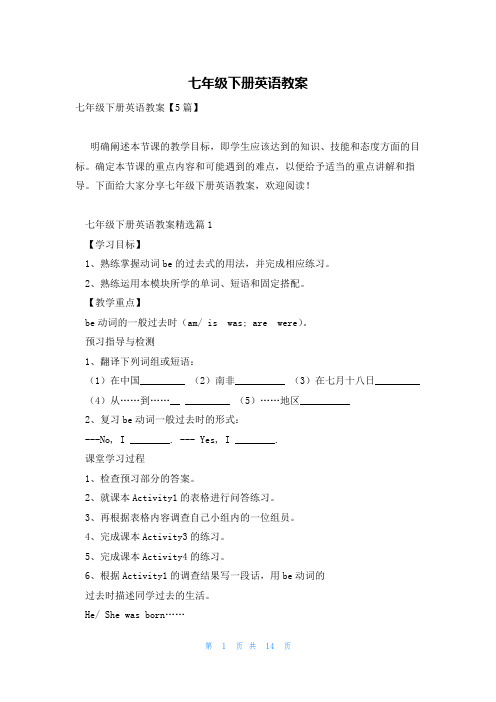
七年级下册英语教案七年级下册英语教案【5篇】明确阐述本节课的教学目标,即学生应该达到的知识、技能和态度方面的目标。
确定本节课的重点内容和可能遇到的难点,以便给予适当的重点讲解和指导。
下面给大家分享七年级下册英语教案,欢迎阅读!七年级下册英语教案精选篇1【学习目标】1、熟练掌握动词be的过去式的用法,并完成相应练习。
2、熟练运用本模块所学的单词、短语和固定搭配。
【教学重点】be动词的一般过去时(am/ is was; are were)。
预习指导与检测1、翻译下列词组或短语:(1)在中国_________ (2)南非__________ (3)在七月十八日_________ (4)从……到……__ _________ (5)……地区__________2、复习be动词一般过去时的形式:---No, I ________. --- Yes, I ________.课堂学习过程1、检查预习部分的答案。
2、就课本Activity1的表格进行问答练习。
3、再根据表格内容调查自己小组内的一位组员。
4、完成课本Activity3的练习。
5、完成课本Activity4的练习。
6、根据Activity1的调查结果写一段话,用be动词的过去时描述同学过去的生活。
He/ She was born……当堂检测Task1. 单项选择:( ) 1. She was born _______ Tianjin.A. atB. inC. on( ) 2. ---______ were you born ---On 2nd November, 1990.A. WhatB. WhereC. When( ) 3. It takes us ten minutes by bike _______ my house______ school.A. to, toB. to, fromC. from, to( ) 4. I was born _______ a winter morning.A. inB. atC. on( ) 5. Who _______ your first friendsA. wasB. wereC. are( ) 6. I remember Mr. Wang was my ______ English teacher.A. oneB. firstC. the first( ) 7. This is a story book _____some colourful pictures in it.A. haveB. hasC. withTask2. 根据首字母或汉语意思提示写单词:1. We can take a shower (沐浴) in a b_________.2. There is a p_______ with some fish in it.3. Nelson Mandela wasn’t he hero of South A_______.4. John Adams was the p_________ of the USA.1. Betty was b______ in Quincy, USA.2. My maths teacher was very s_______ with me.3. What was your p_______ life like4. Tony is f_________ to everyone, we like him very much.6. We have a big g_________ (花园)with lots of flowers in it.8. He was born in a small __________ (村子) in Shandong Province.9. My house is small, but it’s very ______________ (舒适的).10. There were two _________ __________ (影剧院) in the small town. Task3. 连词成句:1. were , born , you , where______________________________________________2. first , school , what , primary , your , what’s______________________________________________3. born , small , was , village , a , I , in______________________________________________.4. wasn’t , in , born , Tony , China______________________________________________.5. President , Africa , of , he , South , was , the______________________________________________.七年级下册英语教案精选篇2教学目标在本节课结束时,学生将能够了解教室环境中物品的`名称并在口语中正确使用My name is… Nice to meet you.等句型简单介绍自己,了解他人的姓名信息,进一步了解新同学;学生将能够了解单元任务的具体要求,并完成自己和小组内成员的姓名部分。
2021年新人教七年级英语下册全英文教案(全册_全英文)
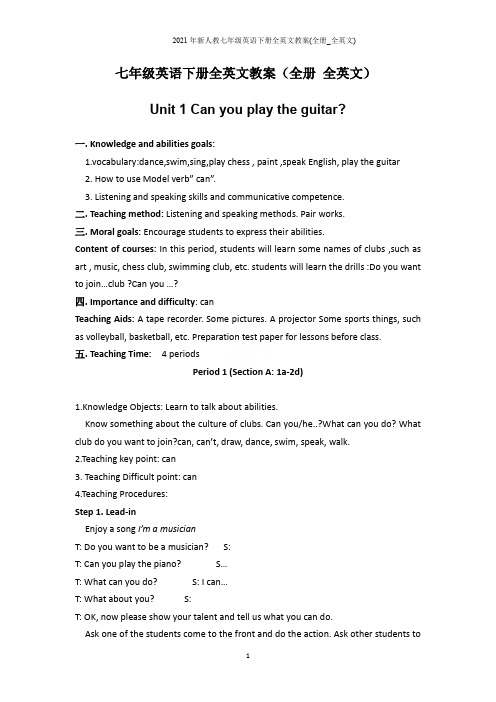
七年级英语下册全英文教案(全册全英文)Unit 1 Can you play the guitar?一. Knowledge and abilities goals:1.vocabulary:dance,swim,sing,play chess , paint ,speak English, play the guitar2. How to use Model verb” can”.3. Listening and speaking skills and communicative competence.二. Teaching method: Listening and speaking methods. Pair works.三. Moral goals: Encourage students to express their abilities.Content of courses: In this period, students will learn some names of clubs ,such as art , music, chess club, swimming club, etc. students will learn the drills :Do you want to join…club ?Can you …?四. Importance and difficulty: canTeaching Aids: A tape recorder. Some pictures. A projector Some sports things, such as volleyball, basketball, etc. Preparation test paper for lessons before class.五. Teaching Time: 4 periodsPeriod 1 (Section A: 1a-2d)1.Knowledge Objects: Learn to talk about abilities.Know something about the culture of clubs. Can you/he..?What can you do? What club do you want to join?can, can’t, draw, dance, swim, speak, walk.2.Teaching key point: can3. Teaching Difficult point: can4.Teaching Procedures:Step 1. Lead-inEnjoy a song I’m a musicianT: Do you want to be a musician? S:T: Can you play the piano? S…T: What can you do? S: I can…T: What about you? S:T: OK, now please show your talent and tell us what you can do.Ask one of the students come to the front and do the action. Ask other students toguess what he or she can do.Step 2. PresentationT: Look at the pictures. What are they doing? S:Step 3 Pair workLook at the pictures. Ask and answer like this:A: Can you play basketball?B: Yes, I can. / No, I can’t. Can you…?Step 4 PresentationShow some pictures of famous stars. Practice the third person “he, she, they”T: Where can you play chess? S:T: Yes, in a chess club. This term, we have a lot of clubs. What club do you want to join? S…T: Sounds great. Can you…?S: Yes, I can/ No, I can’tIf the answer is negative, guide students to say:S: No, I can’t. But I can learn it from others.Step5 Pair workA: What club do you want to join?B: I want to join the…A: Can you …?B: Yes, I can . No, I can’t. But I can learn it from others.Step 6 ListeningListen to 1bListen to 2a and 2b. Tell them to give special attention to listening activity (names of the clubs). Finish the tasks.Step 7 Pair workLook at 2b and talk about what the people can do the clubs they want to join. Step 7 Role-play the conversation 2dT: If you like telling stories. What club can you join?S: Story telling club.T: Right. Please read the conversation following the recording. Who wants to join the story telling club? Then role-play the conversation.Step 8 Explain some language points.Step 9 HomeworkReflection after class:_____________________________________________________________________ _____________________________________________________________________ _____________________________________________________________________ _________________________________Period 2 (Section A: 3a-3c)1. Knowledge Objects: go on learning to talk about abilities.—Can you play the guitar? —Yes, I can./ No, I can't.—What can you do? —I can dance.—What club do you want to join? —I want to join the chess club.2. Teaching key points: Conclude the usage of ‘can’; put all new language into practice through different activities.3. Teaching Difficult points: Distinguish “say, speak, tell, talk”4.Teaching Procedures:Step1:Greeting, Warming up and duty report.Watch a flash about the content of the Just for fun.Talk something about the flash: Why is the other boy unhappy?Introduce because of the difference of time zones, the time in different places are different.Revision: show the time in six places: Beijing, Tokyo, Paris, Los Angeles, New York, and London. Elicit the sentence pattern: What time is it?It’s……Draw attention to the “am” and “pm”. For instance, Beijing is seven o’clock in the morning. We can say Beijing is seven am. Los Angeles is three in the afternoon. So we can say Los Angeles is three pm. (teacher helps students answer).Step2:Review the words learnt in the last period and add more.(1)T:Here are some Chinese, let us see what time do they usually get up/ take a shower…get up take a shower eat breakfast go to school eat lunch run go home do homework eat dinner go to bed(2)ask students to make a surveyAsk your friend 5 questions about his /her day. Then make a report.A: What time do you usually…?B: I usually…at…Step3:presentation.(1)Ben’s day. Introduce something about Ben.Using the sentence pattern: What time does he usually get up/go to school/…Pay attention to the verb form of the third person.Discuss Do you like ben’;s routines.(2)Show the picture of Scott. He usually gets up at 5 pm.Ask students to predict what his job is?(3)listen to the tape,and try to answer this question. then read through the passage,and match the pictures with the times.(4)read it again and fill in the chart.(5)answer the following questions1.Where does he work?2.How does he go to work?Step4:Work on 3a.(1)Read through the passage and tell me what his job is.(2)Read it again and match the pictures.(3)Answer questions:What does he do after he get up?Does he go to work after breakfast? What does he do?How does he go to work? By bus or on foot?What does he do before he goes to bed?What does“What a funny time to eat breakfast!”mean?Step5:Follow up.T:My friend Da Bao likes Scott's work, so he gets to Sai Te Hotel . But he doesn't find him.T: There are many children in the hotel. Look, they are coming. Please ask them questions to find the real Scott.Step6:Work on part4.T:Now six people make a group, and ask the other students when they usually go to bed . The leader lines up from the earliest to the latest bedtime.T: Let's listen Group1…Group2…Step7:Work on part 3 of self –check.T: Now I want to know something about what you do on weekends. You can go, ask your classmates and fill in the forms. Then you have a report.T: You may begin it like this "Ma Li gets up at …"Step8:Homework.Oral work:(1)Read 3a and recite it.(2)Go on making a survey to find out what your classmates do on weekends. Reflection after class:_____________________________________________________________________ _____________________________________________________________________ _____________________________________________________________________ _____________________________Period 3 (Section B: 1a-1f)1. Knowledge Objects: go on learning to talk about abilities. drum, play the drum, piano, play the piano, violin, play the violin2. Teaching key points: Improve listening and speaking3. Teaching Difficult points: Improve listening and speaking4. Teaching Procedures:Step 1 Warming- up and revisionDaily greeting.Check the homework. Let some Ss report what his/her family members can do. Step 2 PresentationPlay the sound of different kinds of instruments. Let Ss guess what it is.Act and show your classmates your talent.T: Please stand in front of your classmates. Act and say what you can.S1: (sing and dance) I can sing and dance.S2: (play the drum) I can play the drum..Step 3 ListeningTell the Ss that they will listen to some sounds of the instruments. Listen and number the words [1-4] in the order of the sounds you hear in 1a.Play the recording again and check the answers.T: Now let's work on 1c. First, let one student read the words and phrases aloud. Then listen to the 1d and circle the words and phrase you hear.Check the answers:T: Now please look at the chart in 1e. What can Bill, Cindy and Frank do? What can't they do? You'll listen to the recording again. Then try to fill in the blanks.Step 4 Group workWork in groups. Take turn to talk about what Bill, Cindy and Frank can and can't do.S1: Bill can play the guitar, but he can't sing.S2: Cindy can sing and play the drum, but he can't play the piano.Teacher can walk around the classroom, and give some help to the Ss.Step 5 HomeworkMake up a conversation between a volunteer and a person who is in charge of a sports club/old people’s home/music club.Reflection after class:_____________________________________________________________________ _____________________________________________________________________ _____________________________________________________________________ ____________________________________Period 4 (Section B: 2a-self check)1. Knowledge Objects: go on learning to talk about abilities. also, people, help (sb) with sth, center, home, today, be good with, make, make friends, weekend, onweekends/on the weekend, teach, musician2. Teaching key points: Also, too; be good with, help with3. Teaching Difficult points: Describe one’s ability4. Teaching Procedures:Step 1 Warming-upCheck the homeworkAsk some pairs to show their conversationsStep 2 ReadingFirst, show some pictures of the boys and girls and some key words in 2a.T: Here are some pictures and information about Peter, Alan and Ma Huan. Can you describe them according to the pictures and key words?S1: Guide Ss to use “also, too”, and distinguish how to use these two words.Give comments on Ss’ descriptions.T: Now we’ll read three ads. What's the main idea of each ad? What's each ad's title? Now let's read the three ads and select a title for each ad. Ss read carefully and try to select a title for each ad. Check the answers with the class.Step 3 Review the usage of “tell”,Review and distinguish the usage and function of “help”T: Suppose Peter, Alan and Ma Huan want to help to do something after school. Which ad is right for him/her? Now read the descriptions in 2a and the ads in 2b again. Select a right ad for each person.Ss read the descriptions in 2a and the ads in 2b again. Try to select a right ad for each person. They can talk about the answers in their groups.Check the answers with the class.Step 4 Homework1. Recite 2a and 2b2. Finish the exercise on p6Reflection after class:____________________________________________________________________ Unit 2 What time do you go to school?1. Teaching Aims:1) Aims of Basic Knowledge:①Vocabulary: time, shower, usually, O’clock, what time, go to school, take ashower.② Grammar: What time do you…? What time does he / she…?③ Function: Use the simple tense to talk about the daily life.2) Aims of Abilities: Listening skill. Speaking skill. Reading skill. Writing skill.3) Aims of Emotion: Love life.2. Analysis of the Material:1) Brief Introduction of the teaching material:What time / When do you…?” “ What time / When does he…?”2) Teaching Focus: What time do you…? What time does he/ she…?3) Teaching Difficulties: Present tense.3. Learning Methods: Make a plan. Culture.4. Teaching Methods: Student- centered. Task-based Teaching.5. Teaching Time: 4 periodsPeriod 1(Section A: 1a-2a)Step One: Warming-upGreetingT: Good afternoon, everyone.Ss: Good afternoon, Miss Yang.Step Two: Presentation1.Adjust the time, and ask students questions.T: What time is it? Ss: It’s 12 o’clock. ( Write on Bb )( Help Ss to say )T: What time is it? Ss: It’s 10:15. ( Help Ss to say )2.Ask one student to come to the front, adjust the time and ask the other students.S1: What time is it? Ss: It’s 9 o’clock.3.Teach the new words & phrases.Show some pictures of different clocks and the activities.T: I’m very busy these days. Can you guess what time I get up / eat breakfast / go to school / run / take a shower? ( Write on Bb)T: I usually get up at 6:35. ( Teach Ss the new word “ usually” )S1: You usually eat breakfast at …S2: You usually run at…S3: You usually take a shower at …4.Ask Ss to do the exercise of 1a, and then check the answers.Step Three: Listening1.Show Ss the timetable of Rick’s ( write on small Bb )Ask Ss listen to the recorder and fill in the chart.Then check the answers.2.Ask and answer.T: What time does Rick get up / eat breakfast / run / go to school / take a shower ?Ss: He gets up / eats breakfast / runs / goes to school / takes a shower at…( Ask Ss pay attention to the underlined phrases.)Step Four: Consolidation1.Ask Ss to look at the pictures and tell their days.Example: I usually get up at …. I eat breakfast at …. I go to school at …. At …, I take a shower.Step Six: Homework1.Try to remember all the words & phrases.2.Survey: Ask your classmates their routines, and give your report.3.Plan: January 1st is coming. Please plan it, and make your day wonderful.Step Seven Blackboard DesignReflection after class:_____________________________________________________________________ _____________________________________________________________________ _____________________________________________________________________ _______________________Period 2 (Section A: 2b-Grammar Focus)1. Aims and demands :1) Language skills :Ss learn to talk about kinds of transportation, and how long it takes to go places, and how far apart places are.2) Target Language : Words : how far , get to , bicycle , subway , bus stop, trainstation , minute, kilometer, mile , transportation , calendarSentences: How do you get to school ? / How long does it take ? / How far is it ? 3) Moral object : Through learning this unit , Ss can enable them to care for each other whenever crossing the roads and pay attention to the sign of traffic.2. Analysis of the material:Students have learned the transportation before.. In this unit ,they need to learn more details about the transportation. At the same time ,they need to learn “How long and How far” and they can use them freely.3. Teaching methods:pairwork , groupwork ,listening and speaking, practicing4, learning strategies:Personalizing Inferring vocabulary5.Teaching aids:Tape recorder, a projector or a computer6.Teaching period:Four periods.Period 3 (Section B: 3a-3c)1. Aims and Demands: Key vocabulary, How do you get to school ? How does he getto school ?2. Teaching methods : Listening Writing Pairwork3. Teaching Aids : A tape recorder.Step I Leading inT: Good morning, everyone! You know I live far away ,so I go to school by bus every day. What about you? David, “How often do you go to school?”S:--------T: So we will talk about how to get to places in this unit.Step IINow I will show you pictures and let’s review the transportations we know. Then we will learn more about it .(take the subway) Please open your books and finish 1a. Step III1. There are five names in 1b.Now they are in the picture. We should find them.2. Play the tape .They should listen carefully and find the persons .Write the numbers next to the correct students in the picture above. After listening , check the answers together .Step IVPoint to the example in the box , ask two students to read it .then ask them to make up their conversations about how the people in the picture get to school . Teacher choose some pairs to act their conversations.Step VPracticing the listening :T: I will play two conversations The people are talking about how students get to school and how long it takes .The first time check the kinds of transportation that you hear. The second time match the time with the kinds of transportation activity 2a.Step VI1. Pay attention to the picture and dialogue.2. Make your own dialogue into pairs.3. Act it in front of the students.Step VIISummary and homework: This class we have learnt some key vocabulary and the target language .I hope after class you can survey how does your friends get to school .and pre-revise the 3a,3b.Step VIII Blackboard DesignReflection after class:_____________________________________________________________________ _____________________________________________________________________ _____________________________________________________________________ __________________________________Period 4设Unit3 How do you get to school ?Period 1 (Section A: 1a-1C)【学习目标】1.掌握本节课的5个单词:train bus subway ride bike和5个短语: take the train take the bus take the subway ;ride the bike walk to2.熟练运用问方式的句型。
(完整word版)新人教版七年级英语下册教案(全)
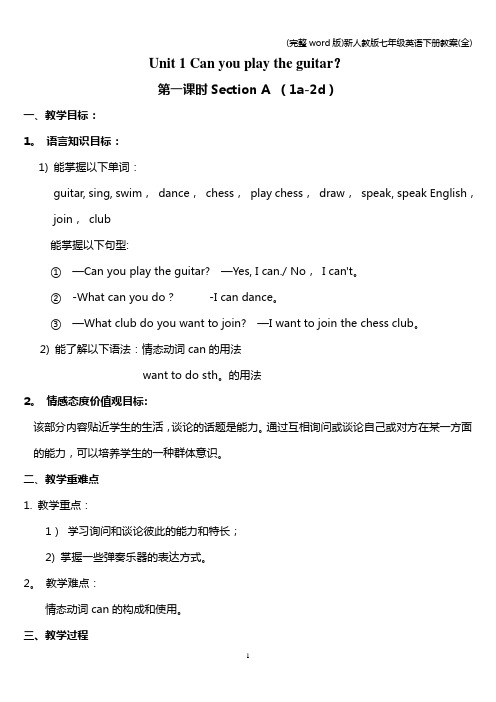
Unit 1 Can you play the guitar?第一课时Section A (1a-2d)一、教学目标:1。
语言知识目标:1) 能掌握以下单词:guitar, sing, swim,dance,chess,play chess,draw,speak, speak English,join,club能掌握以下句型:①—Can you play the guitar? —Yes, I can./ No,I can't。
②-What can you do?-I can dance。
③—What club do you want to join? —I want to join the chess club。
2) 能了解以下语法:情态动词can的用法want to do sth。
的用法2。
情感态度价值观目标:该部分内容贴近学生的生活,谈论的话题是能力。
通过互相询问或谈论自己或对方在某一方面的能力,可以培养学生的一种群体意识。
二、教学重难点1. 教学重点:1)学习询问和谈论彼此的能力和特长;2) 掌握一些弹奏乐器的表达方式。
2。
教学难点:情态动词can的构成和使用。
三、教学过程Ⅰ. Lead in1. 教师可携带一些易于演奏的乐器,也可带一些演奏乐器的图片,一边演示乐器,一边说:I canplay the guitar.…等;再指着图片说:He/She can play the violin.But I can’t play it.等;然后询问学生:Can you play the guitar?….并引导学生进行简单的回答。
2. Ss look at the picture in 1a。
Then read the words and phrases。
Let Ss match theactivities with the people。
Then Check the answers with the class together。
七年级英语下册电子版教案

Unit 1Can you play the guitar?第一课时Section A (1a-1c)1.重点单词:guitar,sing,swim,dance,chess,draw,speak,join,club2.重点短语:play chess,speak English,play the guitar,art club,music club3.重点句式:Can you swim?Yes,I can./No,I can't.I want to join the art club.1.play the guitar,play chess,speak English2.含情态动态can 的一般疑问句及简略回答1.含有情态动词can 的一般疑问句及简略回答一、预习课本P1新单词并识记,完成下面的汉译英。
1.吉他____________ 2.唱歌____________3.游泳____________ 4.跳舞____________5.画______________ 6.说____________7.加入____________8.俱乐部____________二、认真预习1a,1b,1c,找出下列短语和句型。
1.下棋________________________________________________________________________ 2.说英语________________________________________________________________________ 3.弹吉他________________________________________________________________________ 4.艺术俱乐部________________________________________________________________________ 5.音乐俱乐部________________________________________________________________________ 6.你会游泳吗?是的,我会。
部编初一年级英语下册电子教案七下Unit1三课时(1)
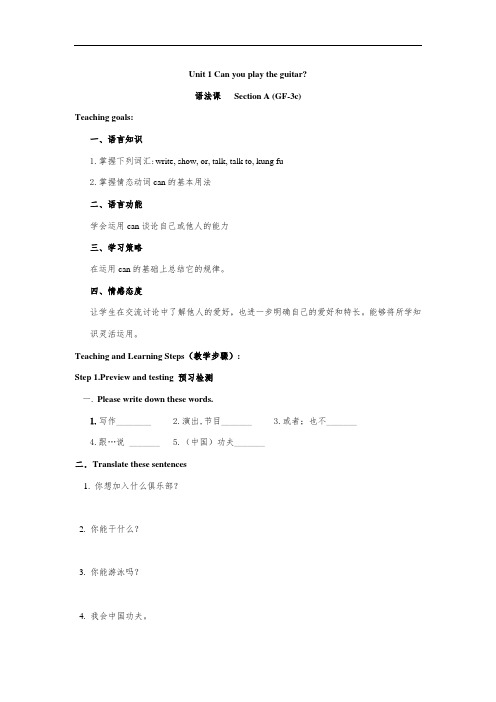
Unit 1 Can you play the guitar?语法课Section A (GF-3c)Teaching goals:一、语言知识1.掌握下列词汇:write, show, or, talk, talk to, kung fu2.掌握情态动词can的基本用法二、语言功能学会运用can谈论自己或他人的能力三、学习策略在运用can的基础上总结它的规律。
四、情感态度让学生在交流讨论中了解他人的爱好,也进一步明确自己的爱好和特长。
能够将所学知识灵活运用。
Teaching and Learning Steps(教学步骤):Step 1.Preview and testing 预习检测一.Please write down these words.1.写作________2.演出,节目_______3.或者;也不_______4.跟…说 _______5.(中国)功夫_______二.Translate these sentences1. 你想加入什么俱乐部?______________________________________2. 你能干什么?_______________________________________3. 你能游泳吗?_______________________________________4. 我会中国功夫。
________________________________________(设计意图:设置前置性任务,为学生下面的学习扫除障碍。
)Step 2.Warming up and leading in热身导入T: Boys and girls, please look at the picture, who is he?Ss: Yao Ming.T: What can he do?Ss: He can play basketball.T: Who is he?Ss:Liu Huan.T: What can he do?Ss: He can sing.T:What can you do? (Point to one student)S1: I can draw.T: What club do you want to join?S1: I want to join the art club.Ask other students the similar questions. Then show them some clubs.(设计意图:谈论熟悉的人物,激发学生兴趣,引起学生话题,同步倒入新课。
初中译林英语七下教案电子版

初中译林英语七下教案电子版教案标题:初中译林英语七下教案电子版教案目标:1. 帮助学生理解并掌握初中英语七年级下册的教学内容。
2. 培养学生的听、说、读、写、译等综合语言技能。
3. 激发学生学习英语的兴趣,培养他们的学习策略和自主学习能力。
教学重点:1. 学习并运用本册教材中的词汇、句型和语法知识。
2. 培养学生的听力和口语交际能力。
3. 培养学生的阅读理解能力和写作能力。
教学难点:1. 帮助学生理解并运用本册教材中的语法知识。
2. 提高学生的阅读理解能力,培养他们的阅读习惯。
3. 培养学生的写作能力,引导他们用英语进行表达。
教学准备:1. 课本:《译林英语七下》电子版。
2. 多媒体设备:电脑、投影仪等。
3. 教学素材:课文、单词卡片、图片、录音等。
4. 学生学习工具:笔记本、课本、练习册等。
教学过程:课时安排:共计30课时,每课时45分钟。
第一课时:1. 导入:通过展示一张关于旅行的图片,引发学生对话题的兴趣。
2. 学习目标:介绍本册教材的学习内容和学习目标。
3. 预习导入:通过播放一段与旅行相关的短视频,激发学生对旅行的兴趣。
4. 新课呈现:通过展示课文中的图片和听录音,引导学生学习新课。
5. 听力练习:播放课文录音,让学生跟读并回答相关问题。
6. 小组活动:学生分组讨论并展示自己的旅行计划。
7. 作业布置:要求学生预习第二课时的内容,并完成相关练习。
第二课时:1. 复习导入:通过复习上节课的内容,检查学生的学习情况。
2. 新课呈现:通过展示课文中的图片和听录音,引导学生学习新课。
3. 词汇学习:引导学生学习本课的生词,并进行相关练习。
4. 语法讲解:介绍本课的语法知识,并进行相关练习。
5. 阅读理解:学生阅读课文并回答相关问题。
6. 听力练习:播放课文录音,让学生跟读并回答相关问题。
7. 作业布置:要求学生预习第三课时的内容,并完成相关练习。
第三课时:1. 复习导入:通过复习上节课的内容,检查学生的学习情况。
- 1、下载文档前请自行甄别文档内容的完整性,平台不提供额外的编辑、内容补充、找答案等附加服务。
- 2、"仅部分预览"的文档,不可在线预览部分如存在完整性等问题,可反馈申请退款(可完整预览的文档不适用该条件!)。
- 3、如文档侵犯您的权益,请联系客服反馈,我们会尽快为您处理(人工客服工作时间:9:00-18:30)。
Unit 1 Can you play the guitar? 第一课时 Section A (1a- 1c)1.重点单词: guitar , sing , swim , dance ,chess , draw , 2.重点短语: play chess , speak English , play the guitar , 3.重点句式:Can you swim ? Yes , I can./No , I can't. I want to join the art club.1. play the guitar ,play chess , speak English 2.含情态动态 can 的一般疑问句及简略回答1.含有情态动词 can 的一般疑问句及简略回答speak , join , club art club ,music clubStep 1 情景导入Hello, everyone. We all know that Jay Chou is a very famous singer. He has many talents, he can sing, he can dance and he can also play the guitar. Can you sing? Can you dance? Can you play the guitar? Please tell us your talents.环节说明:由学生感兴趣的歌手周杰伦过渡到询问对方的才艺,让学生在轻松愉悦的氛围中接收到关于教学目标的信息。
Step 2 完成教材1a-1c 的任务1. 利用图片,呈现词汇(si ng, swim, da nee, drum)及新句型Can you...? (3分钟)2. 听1a录音,学生跟读并模仿语音语调,并将活动和图片中的人物匹配。
(3分钟)3. 听1b录音,并将按你所听到的顺序编号。
(2分钟)4 •听1b录音,核对答案并给予做对的学生掌声鼓励。
(2分钟)5. 小组练习,让学生模仿1a,1b。
使用Can you... ? Yes, I can./No, I can't.编对话,并表演。
(5分钟)参考案例1. A : Can you swim?B : No, I can't.2. A : I want to join the art club?B : Can you draw?A : Yes, I can.6. 小结训练。
(3分钟)(B)1.1 want ____ the art club.A . join B. to joinC. joinsD. joining(D)2. —____ you swim ? —No, I ______ .A . Can; canB . Can; don'tC. Do; can't D . Can; can't环节说明:听说结合,第一时间向学生传达语言目标,通过结对对话练习和小结训练,使语言目标得以强化。
Step 3 问题探究1. can的用法1)我会弹吉他。
I can play the guitar.2)他不会弹吉他。
Hecan't play the_guitar.3)你会唱歌吗?是的,我会。
—Can_yousing?Yes,_l can.can -是情态动词~, 它没有人称和数的变化 , 其后要跟动词原形,变否定句是在can 的后面加not缩写成can't。
变一般疑问句是把can提到主语的前面。
2. play的用法1)弹吉他play_the_guitar2)打篮球play_basketball3)下象棋play_chess弹奏乐器时加"the,和球类及棋类名词连用时不能加the。
3. speak的用法1)说英语speak_Englishspeak作及物动词时,宾语是语言类名词。
4. join的用法1)加入俱乐部join_the_club2)加入到我们中来join_usjoin加入的是某个组织和某个团队。
请同学们做前面课时训练部分。
第二课时Sectio n A (2a-2d)1. 重点单词:tell ,story2.重点短语:English club, swimming club ,be good at,tell stories ,story telling club ,sounds good 3.重点句式:What club do you want to join?What sports can you play?—You can join the English club.—Sound good.1. swimming club ,story telling club2. 含情态动词can的陈述句和特殊疑问句含情态动词can的陈述句和特殊疑问句一、认真预习2a, 2b, 2c和2d找出下列短语和句型。
1.英语俱乐部______________________________________________________________________________ 2.游泳俱乐部______________________________________________________________________________ 3.你想加入什么俱乐部?__________________________________________________________________________4.你做什么运动?_______________________________________________________________________________ 5.你擅长讲故事 ______________________________________________________________________________ 6.—你能加入英语俱乐部。
—听起来很好。
Step 1 情景导入I know you all have many talents, there are many clubs in our school , such as the art club, the music club, the swimming club, the sports club and so on. Can you tell me what club you want to join?环节说明:根据学生的才艺引导他们参加不同的俱乐部 ,引出本节课的学习句型“ What club do you want tojoin ?”Step 2 完成教材2a-2c 的任务1.通过图片方式或情景方式, 呈现新的句式“ What club... ?” (2分钟)2. 听2a录音,并将你听到的俱乐部圈出来。
(2分钟)3. 再听2a录音,将2b中的句子补充完整。
(2分钟)4 . 听2a录音,并模仿语音、语调。
然后利用What club does...want to join ? ...wants to join ... 编造对话。
(5分钟)参考案例A :What club does Lisa want to join?B: She wants to join the...5. 小结训练。
(2分钟)(B)1.My brother can _____ very well. So he wants to join the _______ cl u b .A . swims, swimming B. swim, swimmingC. swimming , swim(B)2.My brother wants ________ the chess club.A . joinB . to joinC. joinsD. join to环节说明:通过听、写、说学习训练让学生了解并掌握语言目标,同时学生的口语表达能力在这一环节得到提升。
Step 3 完成教材2d的任务1. 学生自读对话,回答下面的问题。
(5分钟)1) What club does Bob wa nt to join?2) What sports can Bob play?3) Is Jane good at tell ing stories?4) How many clubs does Jane join?2. 听2d录音,模仿语音语调。
3. 初步理解What club do you want to join? You can join...4. 挑选几组学生表演对话。
5 . 设置情景:你班转来几个学生,了解他们的兴趣、爱好、能力。
四人或五人一组运用所学知识编一段对话。
环节说明:将对话问题化,既能锻炼学生的思维能力又能加深对课文的理解。
Step 4 问题探究1. swimming 的用法1)游泳俱乐部swimming_club动词原形不能作定语,要用v-ing作定语。
2 . What about 的用法1) 他怎么样呢?What about him?2) 游泳怎么样呢?What_about_swimming?What about后面跟人称代词的宾格和v-ing形式。
3 . sou nd的用法1)听起来不错。
That_s oun ds_good.sou nd是系动词,后面要跟形容词。
请同学们做前面课时训练部分。
第三课时Section A (Grammar Focus- 3c)1. 重点单词:write ,show, or, talk2.重点短语:speak Chinese,talk to ,after school,do kung fu 3.重点句式:Please talk to Mr. Zhang after school.What can you do?We want students for the school show.1. 连词but和or的用法2.情态动词can 的用法含有情态动词can的各种句型的构成、预习课本P3新单词并识记,完成下面的汉译英。
1.写2.表演3.交谈4.或者认真预习3a, 3b,:3c,找出下列短语和句型。
1.打篮球2.讲故事3.放学后4.你能做什么?5.放学后和张先生交谈。
Step 1 情景导入Teacher: Can you speak English?Student 1 : Yes, I can.Teacher: Can you write stories?Student 2 : No, I can't.Teacher: What can you do?Student 2 : I can play chess.Teacher: What can you do?Student 3 : I can tell stories...环节说明:通过对话练习复习了所学的句型Can you…,并且自然地引出了本节课的重点句型What can you do?Step 2 完成教材Grammar Focus 的任务1 . 教师可以板书或者利用PPT呈现can与不同人称代词的句子,引导学生总结can的用法;再利用这些句子,师生互动。
